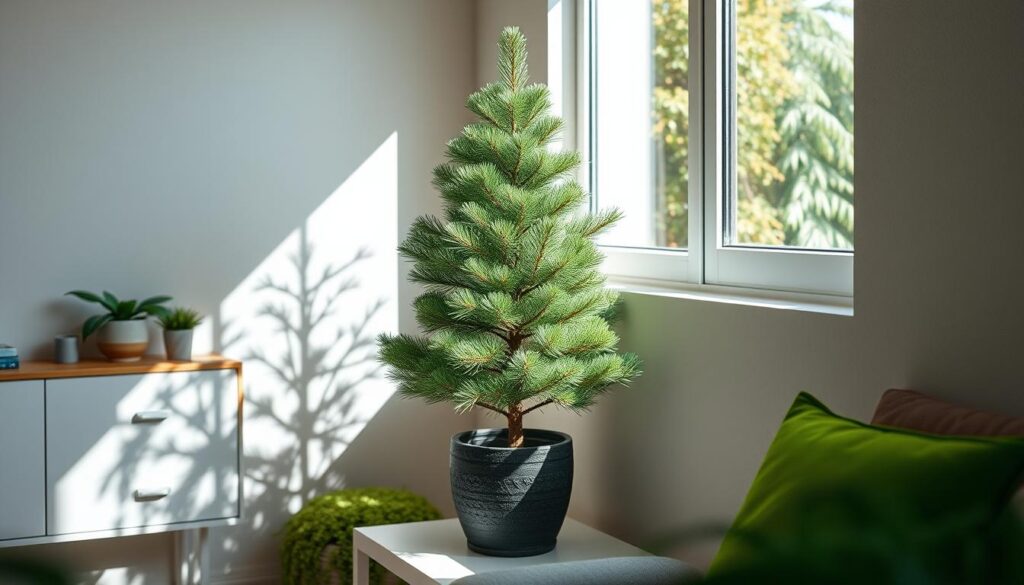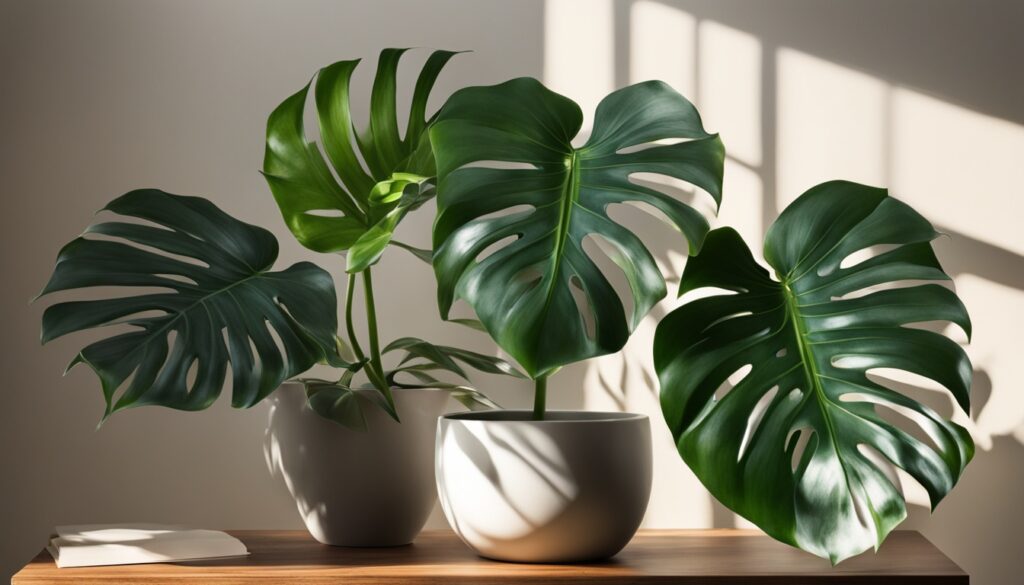Have you thought about adding a pine tree’s beauty to your home? The Norfolk Island pine is a unique houseplant that might be perfect. It has fine, shiny needles and a textured bark, bringing the outdoors inside.
Key Takeaways
- The Norfolk Island pine is a versatile indoor plant that resembles an outdoor pine tree.
- It requires ample bright, indirect sunlight, moist well-draining soil, and regular fertilization to thrive indoors.
- Proper care, including addressing common issues like yellowing needles and branch die-back, is essential for the health of this living fossil.
- Pruning and repotting are important maintenance tasks to keep the Norfolk Island pine looking its best in your home.
- With the right growing conditions, this unique houseplant can add a touch of natural beauty to any living space.
Ready to make your indoor space more beautiful with a Norfolk Island pine? Learn how to care for this special plant and why it’s a great choice for your home.
Understanding Norfolk Island Pine: A Living Fossil
The Norfolk Island pine, known as Araucaria heterophylla, is a unique plant. It’s a living fossil from the ancient Araucariaceae family. This evergreen tree has roots dating back about 200 million years, linking it to the Jurassic and Cretaceous periods.
Botanical Classification and Origins
The tabletop pine, dwarf indoor pine, and apartment pine plant belong to the Araucariaceae family. This group of conifers was once widespread globally. Native to Norfolk Island in the South Pacific, this tree has thrived in its coastal home for centuries.
Natural Habitat and Growth Patterns
In their natural habitat, Norfolk Island pines can grow up to 200 feet tall. Their trunks can be up to 10 feet wide. They have a symmetrical shape and lush green leaves, dominating coastal regions.
But indoors, they grow slower and smaller. They usually reach 3 to 8 feet tall. This makes them great for indoor spaces.
Indoor vs Outdoor Growth Characteristics
The tabletop pine, dwarf indoor pine, and apartment pine plant do well indoors. But they need special care to thrive. Outdoors, they can grow large, but indoors, they stay smaller and more manageable.
With the right care, including proper lighting and watering, they can add beauty to any room.
“The Norfolk Island pine is a living fossil, a remnant of the ancient Araucariaceae family that once dominated the planet millions of years ago.”
Essential Light Requirements for Your Indoor Pine Tree Plant
When growing a miniature pine tree or tiny pine for indoors, light is key. Norfolk Island pines, or bonsai pine, need bright, indirect light. This ensures they grow well and stay green.
These evergreen plants love full sun or south-facing windows indoors. They can handle lower light for a bit, but it makes them stretchy and lose shape. Regular rotation helps them get even light.
Too little light turns needles yellow, while too much can burn the leaves. Finding the perfect light balance is crucial for a healthy, happy miniature pine or bonsai pine indoors.
| Lighting Requirement | Ideal Conditions | Consequences of Improper Lighting |
|---|---|---|
| Bright, indirect light | Placement near south-facing windows or in full sun |
|
Understanding and meeting your indoor pine’s light needs is vital. It ensures your bonsai pine stays vibrant and compact.
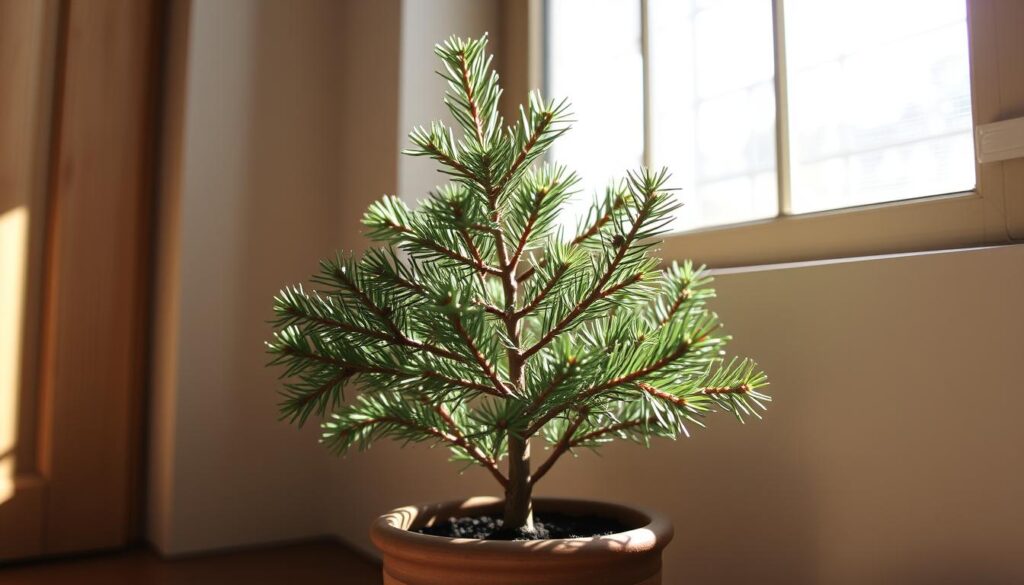
“Providing the right amount of light is crucial for the health and longevity of your indoor pine tree plant.”
Ideal Growing Conditions and Temperature Needs
The indoor pine tree plant, also known as the Norfolk Island pine or houseplant pine, needs specific conditions to stay healthy. These potted pine trees need the right temperature, humidity, and air flow. This ensures they grow well and stay vibrant.
Temperature Range for Optimal Growth
Norfolk Island pines do best in temperatures between 65°F and 70°F. They can handle short periods of cooler or warmer temperatures. But, they can’t survive if it gets below 35°F. Keeping the temperature steady is very important for their health.
Humidity Requirements
Being from tropical areas, indoor pine tree plants need a lot of humidity. You can use a humidifier or a pebble tray to add moisture to the air. This helps them feel more at home.
Air Circulation Considerations
Good air flow is key to prevent fungal problems in indoor pine tree plants. But, they shouldn’t be near cold drafts. Finding the right balance between air movement and avoiding sudden temperature changes is crucial.
“Consistent environmental conditions are crucial for the long-term success of Norfolk Island pines as houseplant pine specimens.”
By giving the indoor pine tree plant the right temperature, humidity, and air flow, you create the best environment. This allows this living fossil to thrive in your home or office.
Soil and Potting Requirements
When caring for your indoor evergreen tree, the right soil and potting setup are key. This is true for both tabletop pine and dwarf indoor pine. The soil needs are similar.
Use a potting mix that drains well, is sandy, and slightly acidic. The best pH for these trees is between 4.5 and 5.5. You can mix peat moss and sand into regular potting mix to get the right acidity and porosity.
Make sure your pot has enough holes for drainage to avoid waterlogging. The soil should be moist but not too wet. If you’re planting outdoors, choose a spot with moist, sandy soil that gets full sun.
| Soil Requirement | Ideal Condition |
|---|---|
| pH Range | 4.5 – 5.5 |
| Soil Texture | Well-draining, sandy |
| Pot Drainage | Adequate drainage holes |
| Soil Moisture | Consistently moist, not waterlogged |
| Outdoor Soil | Moderately moist, porous, sandy, full sun |
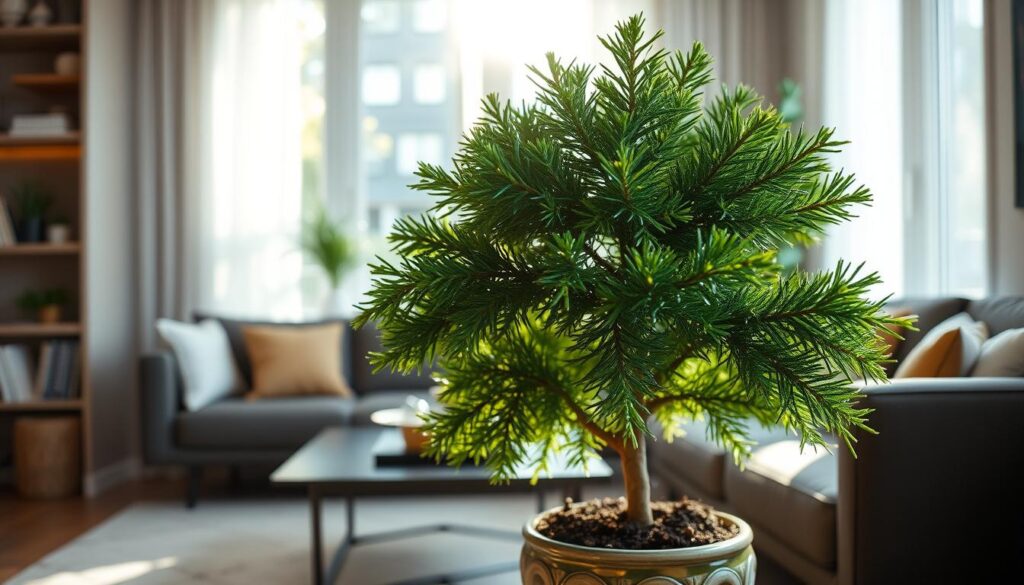
“By providing the right soil conditions, you can create a thriving environment for your tabletop pine or dwarf indoor pine, allowing it to flourish and bring natural beauty to your indoor space.”
Watering Schedule and Techniques
Keeping the right watering schedule is key for your indoor apartment pine plant, miniature pine tree, or tiny pine for indoors. These plants do best when their soil is slightly dry between waterings. This usually happens every one to two weeks.
Signs of Under and Overwatering
It’s vital to watch how your plant reacts to water. If it’s not getting enough water, you might see needles dropping and brown tips. Too much water can turn needles yellow and cause root rot. Change your watering schedule based on what you see and how wet the soil feels.
Seasonal Watering Adjustments
The needs of your indoor pine tree change with the seasons. From spring to early fall, water it more often to keep the soil moist but not soggy. In winter, water it less so the soil can dry out a bit more. Always check the top inch of soil before watering.
To keep your indoor pine tree happy, water it well until water drains from the pot’s holes. Use filtered or distilled water to avoid tap water problems. Daily misting helps keep the humidity right for these plants.
| Watering Frequency | Growing Season | Winter |
|---|---|---|
| Watering Schedule | Every 1-2 weeks | Reduce watering |
| Soil Moisture | Maintain moist, not waterlogged | Allow top inch to dry out |
By sticking to these watering tips and adjusting for the seasons, your indoor apartment pine plant, miniature pine tree, or tiny pine for indoors will stay healthy and vibrant for many years.
Fertilization and Nutrient Management
Proper fertilization is key for your bonsai pine, indoor pine tree, or houseplant pine. These evergreens need a balanced diet of nutrients at the right times. This keeps them healthy and strong all year.
To feed your Norfolk Island pine, use a weak 20-20-20 NPK liquid fertilizer in the growing season. Stop fertilizing in the fall and winter when it’s darker. For better acidity, use fertilizers made for conifers or azaleas.
Feed your plant monthly from autumn to early spring. In spring and summer, when it’s brighter, feed it every other time you water. This regular, gentle feeding boosts the plant’s weak roots and supports growth.
| Nutrient Management Tips | Recommended Practices |
|---|---|
| Fertilizer Analysis | Select a 20-20-20 NPK ratio fertilizer |
| Fertilization Timing | Apply monthly during active growth, suspend during winter |
| Nutrient Considerations | Use acidic fertilizers formulated for conifers or azaleas |
| Application Frequency | Increase to every other watering during peak growing season |
| Fertilizer Benefits | Strengthens the plant’s naturally weak root system |
By following these tips, your bonsai pine, indoor pine tree, or houseplant pine will get the balanced diet it needs. This will help it thrive indoors or outdoors.
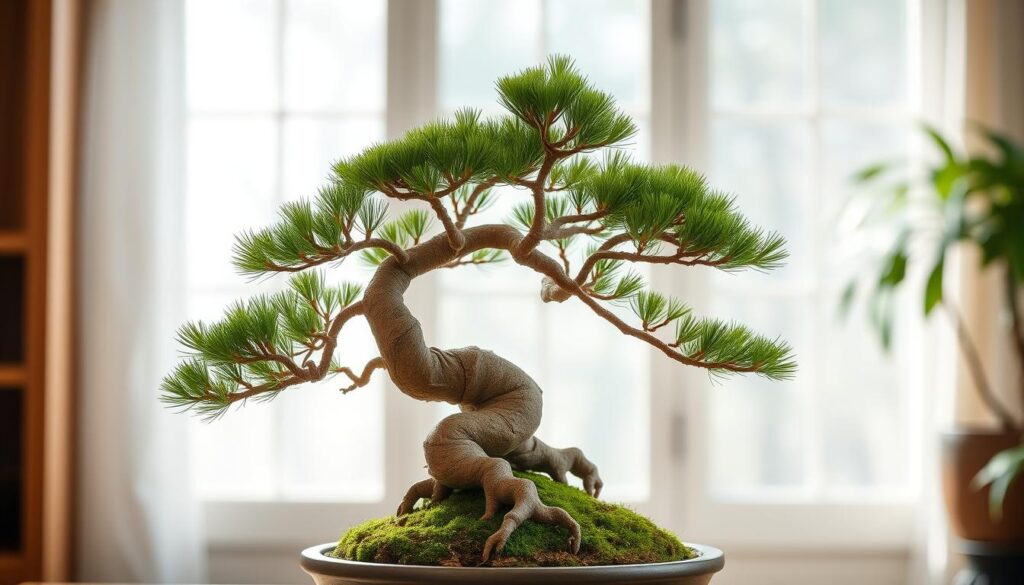
“Proper fertilization is the key to maintaining the health and vigor of your Norfolk Island pine.”
Common Growth Issues and Solutions
The Norfolk Island pine is a tough indoor tree. But, it can still face some common problems. Yellowing needles, brown tips, and slow growth are just a few. Knowing how to fix these issues is key to keeping your potted pine happy and healthy.
Yellowing Needles
Yellow needles on your indoor evergreen tree might mean it’s not getting enough light or nutrients. Make sure your tabletop pine gets enough sunlight. Also, use a balanced fertilizer to help it grow well.
Brown Tips and Branch Die-back
Brown tips and dying branches could be due to low humidity, bad watering, or temperature changes. Keep the humidity steady, water right, and avoid sudden temperature shifts. This will help fix these issues.
Growth Rate Problems
If your potted pine is growing slowly, it might not have enough light or nutrients. Make sure it gets enough sunlight. Also, add a balanced fertilizer to help it grow better.
Fixing these common problems can make your tabletop pine look great again. Just adjust the light, water, humidity, and fertilization. This will keep your indoor tree looking lush and vibrant.
Pruning and Maintenance Guidelines
Keeping your dwarf indoor pine or apartment pine plant looking good is key. These miniature pine trees usually don’t grow over 6 feet tall. They’re great for any room.
To keep your dwarf indoor pine in top shape, focus on the right growing conditions. You don’t need to trim it much. Just remove dead or sick branches to keep it looking neat.
Don’t cut the top of the tree unless it’s really needed. This can mess up its shape. If it gets too big, trim the middle to encourage more branches and control its size.
“Regular pruning facilitates maintaining the Norfolk Pine’s shape and encouraging bushier growth.”
Also, watch out for pests like spider mites and scale on your apartment pine plant. Use neem oil or insecticidal soap to fight off any infestations. This keeps your tree healthy and beautiful.
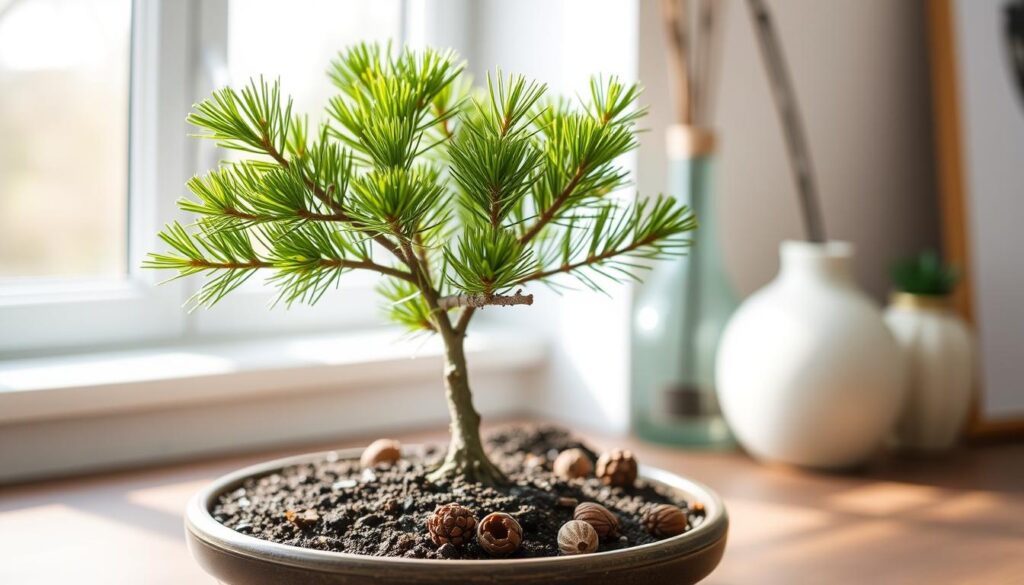
By following these easy pruning and maintenance guidelines, your miniature pine tree will stay vibrant and attractive for many years.
Repotting Your Norfolk Island Pine
To keep your indoor pine tree plant healthy, you need to repot it right. The best time to repot a Norfolk Island pine, a favorite bonsai pine, is in early spring. This is when the plant is growing the most.
When to Repot
Here are signs your tiny pine for indoors needs a new home:
- The roots have filled the whole pot.
- Roots are coming out through the pot’s drainage holes.
Young Norfolk Island pines might need a new pot every other year. But, older plants can go 2-4 years without needing a change, depending on how fast they grow.
Best Potting Practices
When you repot, pick a pot that’s only a bit bigger than the old one. It should be 2-3 inches wider in diameter. Use a mix that drains well and is slightly acidic, made for bonsai pines. Make sure the new pot has lots of holes for water to drain.
For bigger plants, add some weight to the mix to keep the plant from falling over.
After repotting, watch your plant closely. Adjust how often you water it. Look out for signs of shock, like needles falling off. With the right care, your indoor pine tree plant will stay healthy and add beauty to your home.
Indoor Climate Control for Optimal Growth
Keeping your houseplant pine, potted pine, or indoor evergreen tree happy is all about the environment. Aim for temperatures between 65°F and 70°F. Stay away from cold drafts and sudden temperature swings that can harm your plant.
Use a humidifier to keep the air moist, especially in dry places. Grouping your indoor evergreen tree with other plants can also boost humidity. Make sure there’s enough air flow to avoid fungal problems while keeping humidity high.
Where you place your potted pine matters. Keep it away from heating vents, air conditioning units, and direct air flows. With the right climate, your houseplant pine will flourish, adding a lush touch to your home.
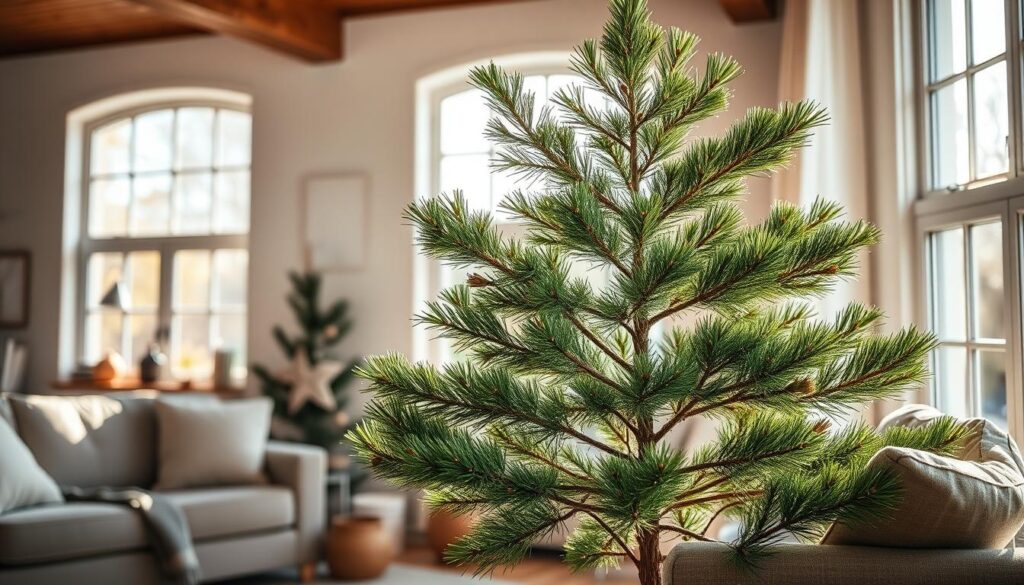
“The key to a happy, healthy indoor pine tree is finding the perfect balance of temperature, humidity, and air circulation.”
Ideal Temperature and Humidity Range
- Maintain temperatures between 65°F and 70°F for optimal growth
- Increase humidity levels using a humidifier or by grouping plants together
- Ensure adequate air circulation to prevent fungal issues and maintain high humidity
Placement and Exposure
- Position your houseplant pine away from heating vents, air conditioners, and drafts
- Provide bright, indirect sunlight or supplement with grow lights for 6-8 hours per day
- Avoid placing the indoor evergreen tree in direct, intense sunlight to prevent leaf scorch
Winter Care and Protection
As winter comes, your tabletop pine, dwarf indoor pine, or apartment pine needs extra care. These plants, even though from warm places, need special help to stay healthy indoors during cold months.
One big worry for indoor pines in winter is frost and cold below 35°F. If your pine is outside, move it inside before the first frost. Keep it away from cold air and heaters to prevent dry leaves.
In winter, your pine grows slower, so water it less often. But, keep the air around it moist to stop leaves from drying. You can use a humidifier or mist the leaves often to keep them moist.
Even though your pine likes bright, indirect light, finding the right amount can be hard in winter. Grow lights can help give your pine enough light to stay green and healthy.
Don’t fertilize your pine in winter. It’s growing slower, and too much food can hurt it. If you need to fertilize, use a light, slow-release or organic one, following the instructions carefully.
By following these tips, your pine will stay healthy and green all winter. It will bring a bit of the tropics to your home.
Key Considerations for Protecting Your Indoor Pine in Winter
- Bring outdoor pines indoors before the first frost
- Position the pine away from cold drafts and heating vents
- Reduce watering frequency but maintain high humidity levels
- Use grow lights to supplement natural light during the winter
- Avoid fertilizing during the dormant winter months
| Winter Care Tip | Importance |
|---|---|
| Protect from Frost and Cold | Pines are susceptible to damage from frost and temperatures below 35°F, so it’s crucial to keep them in a warm, protected environment. |
| Adjust Watering Schedule | Reduce watering frequency but maintain humidity to prevent needle drop and drying out. |
| Provide Supplemental Lighting | Use grow lights to ensure your pine receives adequate bright, indirect light during the shorter winter days. |
| Avoid Fertilizing | Pine growth naturally slows in winter, so fertilizing can do more harm than good. Stick to light, slow-release or organic options if needed. |
Disease Prevention and Management
Keeping your miniature pine tree, tiny pine for indoors, or bonsai pine healthy is key. You need to watch out for pests and diseases. With the right care, you can keep your plant safe from common problems.
Common Pests
Norfolk Island pines can get pests like aphids and mealybugs. Scale insects, mites, and whiteflies are also a risk. Check your plant often and treat any pests quickly with safe methods.
Disease Identification and Treatment
Fungal diseases, like anthracnose, can harm miniature pine trees. Look out for yellow or brown leaves, signs of too much water or bad air. To avoid diseases, water right and keep air moving. Check your plant often and isolate sick spots to stop disease spread.
| Disease | Symptoms | Causes | Treatment |
|---|---|---|---|
| Fusiform Rust | Swollen, spindle-shaped galls on branches and stems | Fungus Cronartium quercuum f.sp. fusiforme | Prune and dispose of affected areas, fungicide application |
| Needle Rusts | Yellow, orange, or reddish-brown spots on needles | Fungi in the genus Coleosporium | Fungicide treatment, improve air circulation |
| White Pine Blister Rust | Cankers, wilting, and dieback | Fungus Cronartium ribicola | Remove nearby Ribes species, fungicide application |
Stay alert, tackle problems fast, and keep your plant in the best conditions. This way, your miniature pine tree, tiny pine for indoors, or bonsai pine will stay healthy and avoid pests and diseases.
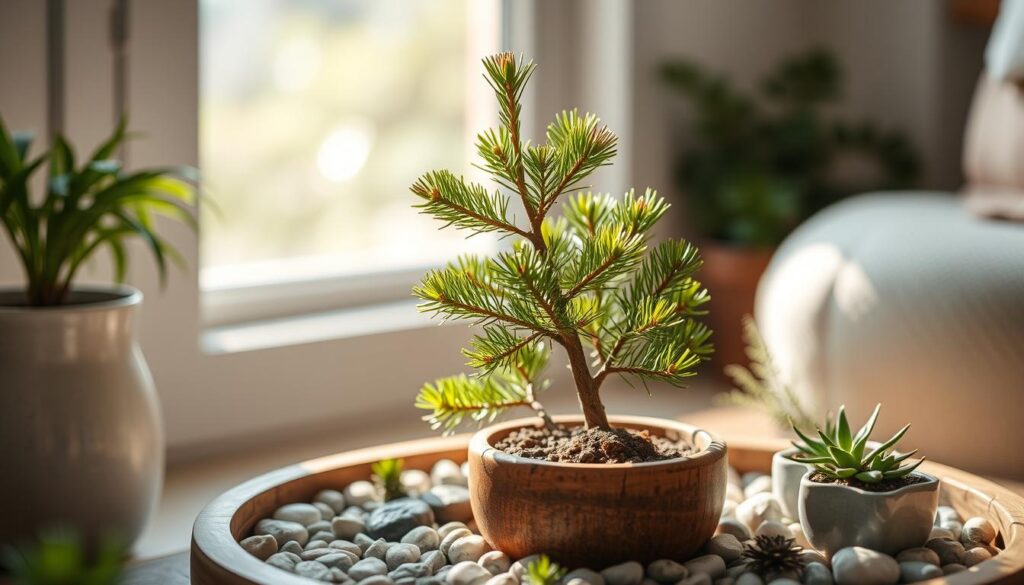
Decorative Uses and Styling Tips
The Norfolk Island pine is a versatile indoor plant that can make any space look better. These trees are perfect as living Christmas trees, decorated with ornaments and ribbons. They also add elegance to any room all year round, bringing a touch of the tropics.
Place your indoor pine tree plant in bright, airy areas. Or group them together for a stunning display. You can even train your houseplant pine as a bonsai for a unique look that fits both modern and traditional decor.
Choose a full-sized potted pine or a compact bonsai. The Norfolk Island pine’s shape and lush leaves make it a standout in any room. Let it add beauty to your home with its tree-like presence.
